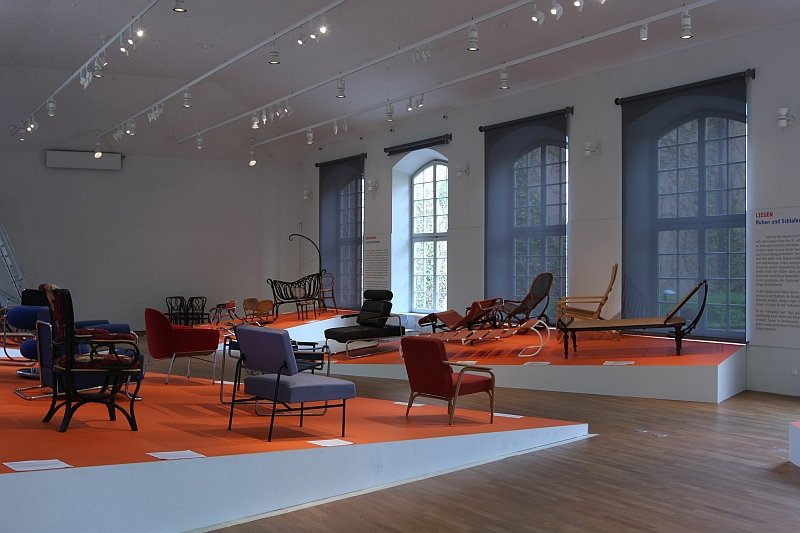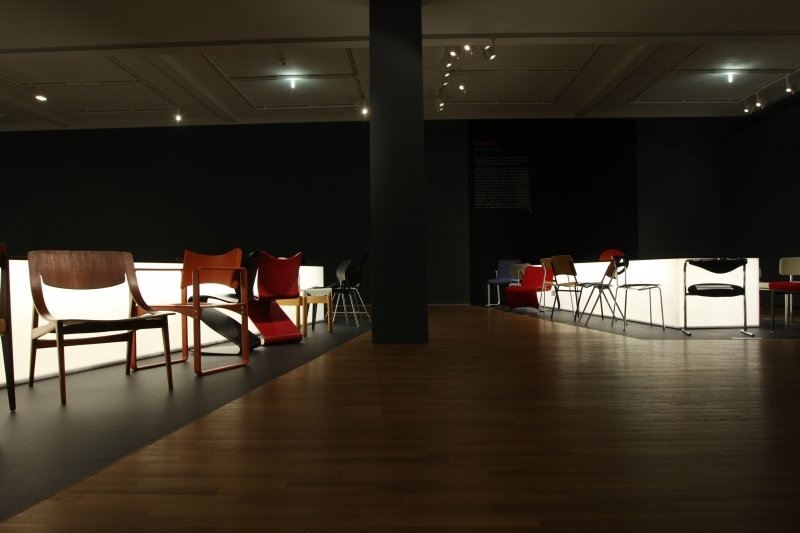Standing in the Leipzig Grassi Museum for Applied Arts, surrounded by 150 years of Thonet chair history, Peter Thonet, x-times-great grandson of company founder Michael Thonet and until his recent retirement company CEO, is clearly a very satisfied man, "It makes one proud to be able to look back on a collection of objects that have not only been important for the company, but which have also, occasionally, written design history"
Few visiting the new Grassi Museum exhibition "Sitting – Lying – Swinging. Furniture from Thonet" could or would argue.

Established by Michael Thonet in "the 1840s", Thonet grew from the backyards of Vienna to become one the world's largest and most commercially successful furniture manufacturers. Success with bent wood - ask any Thonet staff member and they will happily confirm that between 1859 until 1930, around 50 million of Thonet's pioneering Chair 14s were sold worldwide - was followed by success with bent steel tube, for all through works by designers such as Mart Stam, Marcel Breuer or Mies van der Rohe, before, as so often in European biographies, the war years got in the way.
From the seven Thonet production facilities that were in operation before 1939 only the base in Frankenberg (Eder) near Kassel in Germany remained after 1945. The rest either destroyed by war or nationalised by socialist regimes.
Frankenberg was also badly damaged by allied bombs, but there was enough standing to allow the Thonet family to begin again. And begin again they did.
Today Thonet employ around some 170 staff in Frankenberg producing a mix of classic Thonet products and more contemporary designs.
Presenting some 150 objects, Sitting – Lying – Swinging explores the story and history of Thonet chairs with a special, though not exclusive, focus on those works realised since 1945.
Organised by thematic, material and functional criteria rather than presenting the works purely chronologically, Sitting – Lying – Swinging freely mixes historic with contemporary objects and established Thonet classics with little known pieces; a curatorial decision that helps one to understand and follow the story of Thonet seating.
In the first half of the exhibition each section is arranged around a central, illuminated island, an arrangement that gives one the impression of visiting a hotel sushi bar: but an arrangement which does greatly aid the viewing. The second room, with its views into the Grassi courtyard is arranged in a more conventional museum style, but is sparsely enough populated to allow one to ignore the presentation and enjoy the objects.
As more regular readers will know we like to say that Thonet were responsible for two furniture industry revolutions, bent wood furniture and bent steel furniture. And that we’re all still waiting for third. Sitting – Lying – Swinging doesn’t provide any great hope that the third is coming any time soon, but demonstrates if it doesn’t arrive, that isn’t because Thonet as a company have been sitting back on their laurels.
For all since 1945 Thonet have worked with an impressive roster of German and international design talent including, for example, Ferdinand Kramer, Verner Panton, Gerd Lange, James Irvine or Naoto Fukasawa, designers who have not only helped keep the company portfolio fresh but who have introduced new ideas into the company's philosophy.
Those of you who read our thoughts on Artek in Milan will no doubt now be asking why we feel it's OK for Thonet to work with new designers, but Artek should just keep putting out the works of Alvar Aalto?
Those who read our thoughts on Artek in Milan properly will understand that we've nothing against established firms such as Thonet or Artek working with new designers, they must just keep focussed on their core competence. On those things they do well.
With Konstantin Grcic and Hella Jongerius Artek have worked with two designers who have utilised and extended Arteks' core competences, and viewing Sitting – Lying – Swinging one sees clearly that Thonet's most impressive, convincing and successful post-war creations are and were those where the designers have understood Thonet and have attempted to do something new, yet something that is still "Thonet". It sounds ridiculous, but a company must be comfortable with what they are doing if they are to break new ground. From Thonet's most recent collaborations special mention in that respect must go to those with, amongst others, Läufer + Keichel, Delphin Design and Stefan Diez.
And for us the reverse is one of the reasons why the company lost their way a little in the 1980s. In our opinion too many of the chairs from that period were conceived with the aim of reinventing the Thonet brand, rather than advancing chair design. And such can never work.

Viewing Sitting – Lying – Swinging there comes an, inevitable, moment when the question arises, when does an exhibition about Thonet chairs become a sales promotion for Thonet chairs?
A question that given that we see a Thonet trade fair stand every six months or so probably comes quicker to us than to most normal visitors.
The answer is, it doesn't. If, as in the case of Sitting – Lying – Swinging the commercial interests have no influence over the museal content.
Sitting – Lying – Swinging has been curated by the Grassi Museum alone and all aspects organised by the Grassi Museum alone, Thonet merely allowed the Grassi team access to the archives to research.
Thonet is a very valid subject for a museum exhibition, Sitting – Lying – Swinging is the first exhibition ever to place a focus on Thonet's post-war production and is one of the most comprehensive Thonet exhibitions ever staged. The Grassi Museum with its history going back almost as far as Thonet's and being an institution that helped propagate the fledgling Bauhaus, is a fairly logical place for such an exhibition. And not mentioning Thonet in such an exhibition would be a little difficult. And daft.
One must also understand that the the majority of the chairs on show aren't currently in production, and in all probability never will be again. They are, in effect, historical artefacts being presented in a curated museum environment.
And should be enjoyed as such.
Sitting – Lying – Swinging is a very simple exhibition that doesn't attempt to do anything very complicated. Something it achieves with great competence.
Obviously if you don't like chairs, don't go, you'll not enjoy it. It's two large rooms full of chairs.
If however you do like chairs, or at least want to learn how chair design has developed over the past 150 years, how little chair design has developed over the past 150 years, and for all where Thonet fit into the history of chair design, then do go.
You will enjoy it.
Sitting – Lying – Swinging. Furniture from Thonet runs at the Grassi Museum for Applied Arts, Johannisplatz 5-11 04103 Leipzig until Sunday September 14th 2014.
Full details can be found at www.grassimuseum.de